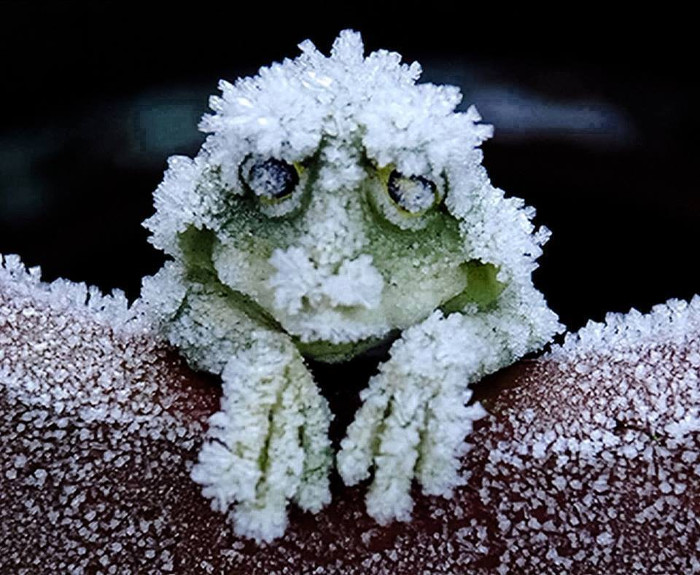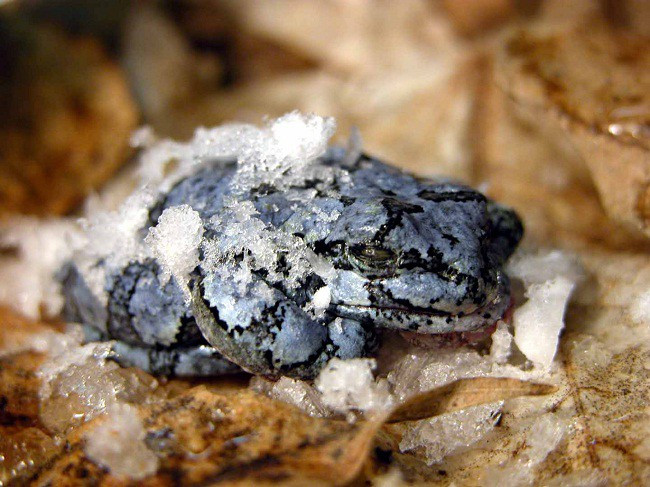Cold-blooded creature
Many people are surprised by the "freezing" mechanism of this cold-blooded creature.
When winter comes, the animals also have different ways to avoid coldness such as hibernation, burrowing underground, migrating to warmer places .
But there is a "cold-blooded" creature that possesses great cold tolerance despite the temperature dropping to minus 14 degrees Celsius. The creature is the Alaskan wood frog .

Cold-blooded frog "died" winter, relive spring.
Few people suspect that Alaska wood frogs are arguably the best cold-tolerant species in vertebrates when it can "petrify" for nearly 7 months at an average temperature of minus 14 degrees C. And then when the season winter passed, spring came - these frogs miraculously resurrected.
It should be clearly stated that frogs are a cold-blooded species and their body temperature usually varies with their surroundings. If the temperature drops to 0 degrees Celsius, the frog begins to freeze.
But frogs don't turn into a piece of ice! According to Livescience, a series of phenomena will occur to protect frogs so that they do not freeze completely.
Just a few minutes after the bandage formed on the skin, the liver of Alaska wood frogs will begin to transform the glycogen storage pathway into glucosen. Glucosen released from the liver transports blood to all organs, thereby protecting the cell from dehydration and shrinking.

During this "hibernation ", about 70% of frog bodies will freeze.
Even if the frog is frozen, its heart continues to pump glucose to protect the body, but then the process will slow down and stop.
All other organs in the frog body such as metabolism and elimination will stop working. Now, frogs don't use oxygen anymore, frogs are now like a corpse.
During this "hibernation ", about 70% of frog bodies will freeze. If it is too cold, frogs may also die, but according to Jon Costanzo, a physiologist at the University of Miami (Ohio), frogs may survive in the heat down to minus 9 - minus 14 degrees. C.
When the weather gets warmer, Alaska wood frogs will gradually revive. Ecologist Jon Costanzo thinks that frogs will experience a period of physical re-movement.

The waste in frog urine plays a role in helping frogs survive the freezing stage.
When the ice melts, the frog may be slightly lethargic because some damaged cells will be replaced. However, experts still wonder what makes the frog's heart beat again.
Through research, experts say, urea - the waste in frog urine plays a role in helping frogs survive the freezing stage. Perhaps, proteins that attach to the inside, outside of the cells, prevent them from contracting to exhaustion, thus fighting the ice.
Researchers believe that, through understanding this freezing mechanism of wood frogs, they will be able to find a method of freezing, defrosting organs and living tissue to serve transplantation techniques in children. people.
- What is cold-blooded animals? Basic information you need to know
- What would happen if humans were ... 'cold-blooded animals'?
- Signs that dinosaurs are warm-blooded animals
- Cold-blooded animals are able to adapt quickly to climate change
- New hypothesis about dinosaurs
- Decipher the mystery of the dinosaur's blood
- New discovery: Dinosaurs are not cold-blooded!
- Cold-blooded insects: Sand trap, sucking flesh inside prey
- Shocked with research into turning mice into 'cold blooded assassins'
- The 5 reasons why killer whales are 'cold-blooded' geniuses of the ocean
- Animals live longer in colder climates
- The dinosaurs also have warm blood
 Animal 'suffering' after hibernation
Animal 'suffering' after hibernation Why do goats climb well?
Why do goats climb well? Scientists were surprised to see chimpanzees eating turtles
Scientists were surprised to see chimpanzees eating turtles Giant catfish died deadly due to drought in Thailand
Giant catfish died deadly due to drought in Thailand